1. “The US has just announced we can have a free Trade Deal with them the day after Brexit.”
I don’t remember Nancy Pelosi agreeing to this!
(Thread)
I don’t remember Nancy Pelosi agreeing to this!
(Thread)
https://twitter.com/LanceForman/status/1162257494787256326
2. David Henig suggested to me that the issue I raised on the GATT requirement was not as poignant as the actual Congressional approval. This is fair, but the Trade Promotion Act becomes more important in terms of trying to do deals quickly.
3. If the president wants to follow the “fast track” procedure he must notify his negotiation intent 90 days before he begins, including the details of when he intends to initiate those negotiations. 

4. He must also inform the Ways and Means Committee 30 days before initiating negotiations of a summary of the specific objectives and the expected benefit. 

5. He must also submit to the International Trade Commission, 90 days before he enters into the agreement, with the details of the agreement as it exists at the time. 

7. And the agreement must be available to the public on the United States Trade Representative’s website 60 days before the president intends to sign the agreement. 

8. The executive can’t possibly meet the requirements of the fast track procedure. After I pointed this out, Jim Cornelius asked if there was a way around this.
The answer is: Yes, the slow way!
The answer is: Yes, the slow way!
https://twitter.com/Jim_Cornelius/status/1161486838655307776
9. Firstly, the President negotiates a deal and gets supporters to raise the necessary legislation in the House and the Senate. Usually a resolution of ratification, and any supporting legislation that needs House approval. (Tariff reduction is the obvious one here)
10. In the Senate, since it’s a trade agreement, it gets directed to the Committee on Finance as per Rule XXV of the Senate Rules. The treaty text is then made available to the public.
11. Historically the Senate try to complete their committee phase within 1-2 years. That usually gives the US electorate plenty of time to see what their government is planning to do.
12. Fortunately they don't all take that long, but the Committee will spend time seeking expert advice and listening to testimony from supporters and non-supporters of the bill.
13. If the bill looks like it has support, the committee will also be voting on various proposed amendments during a ‘mark-up’ session. When an amendment is made, the President is expected to relay these changes to the party he has negotiated the agreement with.
14. In recent years the Senate has put explicitly included requirements for the President to relay the changes to the country the treaty is with and that the country formally agree to those changes.
15. The Committee can then vote to send it for “floor action”, or they can table it and in doing so, effectively kill the bill by sending it into limbo.
16. If the proposal is sent for floor action, the Majority leader Mitch McConnell, or another senator, can create a motion to proceed, which results in a debate and a vote.
17. A vote can be delayed by a senator simply telling the majority leader that they are intend to filibuster, and if that senator have 41% backing them, then the majority leader will save time and not bring it that day.
18. Alternatively the Majority leader can ask “Unanimous consent” which requires nobody to object to this request before a debate on the actual bill is made. If someone says they will object to it, the Bill is said to be placed on hold.
19. Once the decision to bring to the floor has been made, it can also be filibustered. So a motion to proceed doesn’t necessarily mean the bill is going to arrive any time soon.
20. Even with no filibuster, there is no restrictions on the debate time or the number of amendments that can be proposed.
21. If, and when, it gets on the floor and debate can be ended, the vote is no longer the simple majority required by 'fast track' which is a Congressional-executive agreement and it will now require the full two thirds majority.
22. Things are slightly different in the House of Representatives. The bill would likely be sent to the trade subcommittee. This will also seek advice, debate, and conduct a mark-up process with amendments voted for.
23. When the subcommittee is complete they must refer their output to the Ways and Means Committee who goes through that same process again, before rejecting the bill or voting it for ‘floor action’.
24. It will then be down to the House Speaker, Nancy Pelosi, whose job it is to decide which bills come forward, when, and in what order.
(Take note...)
(Take note...)
25. If she brings a bill forward under the ‘Suspension of the Rules’, that limits the debate to 40 minutes and no amendments are allowed. It does mean a two thirds majority it needed to pass.
26. Or she can ask the House Rules Committee to start the process for bringing forward the bill for a lengthy consideration with multiple amendments.
27. The House Rules committee would then work closely with Nancy Pelosi to decide what limitations would be put on the debate and amendments. This results in a ‘Special Rule’. (Or it could also lead to the bill being abandoned).
28. The ‘Special rule’ specific to that bill is then taken to the House and voted on.
Only if it is accepted can the actual debate begin.
Only if it is accepted can the actual debate begin.
29. This is more efficient than the Senate. Debate is not open to all subjects, and usually happens as part of the Committee of the Whole where each proposed amendment is voted on by simple majority.
30. When the Committee of the Whole is complete they report to the house any recommended amendments (which are usually approved).
31. There is then another debate and vote on a motion to recommit, allowing the minority party to propose its own amendment.
32. Then there is a final passage vote.
(This is not a simple process in either place)
(This is not a simple process in either place)
33. Now we have both the Senate and the House or Representatives with different bills with different amendments. Usually this ping pongs between the institutions until it is agreed. This involves more debates, votes and amendments.
34. It also involves the Senate making a motion to disagree or agree, which again can be filibustered, opening up the possibility of even more delays.
35. If it doesn’t get agreed, there can be a motion to move to Conference Committee which brings both chambers together.
(This can also be filibustered)
(This can also be filibustered)
36. A Conference Committee is then created from people drawn from the relevant committees and results in more debates and more votes.
37. If, and when, the Conference Committee come to resolution, it produces a report. The Senate can filibuster, and even if it doesn't, the debate can't start for 48 hours after the details are available to the public, or this rule is waived by, for example, a three fifths vote.
38. Meanwhile in the House of Representatives, Clause 8(a) of Rule XXII means it can only vote on the Conference report after 72 hours has passed.
39. In short, Bills can be passed quite quickly if there is broad support, but controversial bills need the support of the Leader of the House and a supermajority support in the Senate, or things are not going to move quickly.
40. The average time for a bill is about 215 days, and we are being told they can pass this in 28 scheduled days in the Senate, and 25 schedules days in the House. It’s insulting.
As David Allen Green would say: There is not enough legislative time.
As David Allen Green would say: There is not enough legislative time.
41. At this point, you may think Fast Track would help, and before 2008 the President could bring the agreement for consideration within 90 days, but the House Speaker at the time wasn’t happy that this wasn’t a decision of the house.
Her name was Nancy Pelosi.


Her name was Nancy Pelosi.



44. Without Nancy Pelosi backing a trade agreement on November 1st, there will be no trade agreement.
To think otherwise is to ignore the process and exactly what part she plays in it.
To think otherwise is to ignore the process and exactly what part she plays in it.
https://twitter.com/SpeakerPelosi/status/1118625935794868225
• • •
Missing some Tweet in this thread? You can try to
force a refresh











